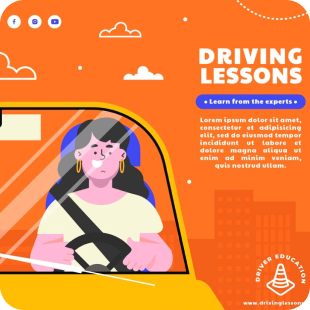- G1 Practice Test Quiz 1 (Signs 1)1
- G1 Practice Test Quiz 2 (Signs 2)2
- G1 Practice Test Quiz 3 (Rules 1)3
- G1 Practice Test Quiz 4 (Rules 2)4
- G1 Practice Test Quiz 5 (Rules 3)5

Tria test G1
Test 5
Our development team has created this powerful online testing engine to help you quickly prepare for the driving regulations exam.
Objects that are not visible in the side mirrors and the center mirror of the vehicle are referred to as .......... of the vehicle
A. Danger Zone
B. Blind Spot
C. Dark Zone
D. Safe Zone

Sliding is usually the result of ..........
A. Driving at high speed
B. Hard braking
C. All options are correct
D. Rapid acceleration

In any situation, a driver must maintain a speed that allows them to:
A. Stop within 150 meters
B. Stop within 90 meters
C. Stop within 60 meters
D. Stop at a safe and secure distance

When a vehicle is waiting for pedestrians to cross at a crosswalk, what is the duty of drivers?
A. They must wait; drivers should not overtake vehicles within 30 meters of the crosswalk
B. They should honk to make the vehicle move
C. They should overtake from the left of the vehicle
D. They should overtake from the right of the vehicle

What is the closest distance a driver can park from a fire hydrant?
A. 3 meters
B. 2 meters
C. 6 meters
D. 5 meters

If the vehicle's wheels drift off the road, the driver should
A. All options are correct
B. Firmly grip the steering wheel and do not brake hard
C. Keep the vehicle under control and steer back towards the road
D. Remove your foot from the accelerator and allow the vehicle to slow down naturally

Regardless of the speed limit sign, what is the maximum allowed speed on highways outside of cities, small towns, and residential areas?
A. 60 km/h
B. 80 km/h
C. 100 km/h
D. 50 km/h

If a vehicle tire blows out, the driver should
A. Brake and turn the steering wheel to the left
B. Brake quickly and hard
C. Brake and turn the steering wheel to the right
D. Remove your foot from the gas pedal to slow down, hold the steering wheel firmly, and steer the vehicle in the desired direction

What is the penalty for not using a child seat or booster seat according to the law?
A. Four demerit points
B. Up to $1500 fine and three demerit points
C. Three demerit points
D. Up to $1000 fine and two demerit points

Driving at the maximum allowed speed at night is more dangerous than during the day because......
A. Some drivers illegally drive using only their sidelights
B. Roads are more slippery at night
C. Drivers’ visibility range, even with the headlights on, is less than during the day
D. Drivers react slower at night

Except when drivers intend to overtake or turn left, they must:
A. Drive on the right shoulder of the road
B. Drive on the left side of the lane and in multi-lane roads, they should drive in the left lane
C. Drive in the center of the lane
D. Drive on the right side of the lane and in multi-lane roads, they should drive in the right lane

Holders of graduated licenses are prohibited from driving in which case?
A. At all hours of the day
B. While consuming any amount of alcohol
C. When the blood alcohol level exceeds 0.08%
D. Without the accompaniment of a supervisor or observer

What is the hand signal for a left turn?
A. Extend your arm out of the vehicle and bend it downward at the elbow
B. Extend your arm horizontally out of the vehicle
C. Circular motion of the hand
D. Extend your arm out of the vehicle and bend it upward at the elbow

Drivers who fail to perform a breathalyzer or blood test upon police request or refuse to do so:
A. Receive a warning letter by mail
B. Their license is immediately suspended for 30 days
C. Their license is immediately suspended for 90 days
D. Their license is immediately suspended for 7 days

What are the hand signals for slowing down or stopping?
A. Circular motion of the hand
B. Extend your arm out of the vehicle and bend it downward at the elbow
C. Extend your arm horizontally out of the vehicle
D. Extend your arm out of the vehicle and bend it upward at the elbow

When a red "X" sign is displayed in a lane
A. You are approaching a traffic light
B. Drivers should not enter or remain in the designated lane
C. The red "X" sign is for pedestrians
D. Drivers must stop immediately

When turning, what should the driver first notice?
A. The height of the curbs
B. The turning radius of the street
C. Traffic signs
D. Weather conditions

When facing an oncoming vehicle with high beams on, what should you do?
A. Look at the headlights of the oncoming vehicle
B. Look up and slightly to the right of the light coming towards you
C. Blink quickly
D. Use high beams as well

What is the minimum distance that drivers must maintain from emergency vehicles that have their sirens and lights activated?
A. 150 meters
B. 100 meters
C. 250 meters
D. 50 meters

In inclement weather such as rain, snow, fog, and mist, how should the vehicle’s headlights be set?
A. It doesn’t matter, just keep the headlights on
B. In these conditions, the headlights should not be on
C. High beams
D. Low beams

If one of the front tires goes flat, which direction will the vehicle pull?
A. Towards the flat tire
B. To the right
C. To the left
D. Towards the edge of the road

If you want to reverse to the left....
A. Turn your body and head to the left and look over your left shoulder
B. Turn your body and head to the left but do not look over your left shoulder
C. Turn your body and head to the right and look over your right shoulder
D. Turn your body and head to the right but do not look over your right shoulder

When accumulating 15 demerit points, the driver’s license will be suspended for 30 days. After the suspension period ends, the number of demerit points that a permanent license holder will have reduces to ..........
A. 10
B. 5
C. 7
D. 3

What should drivers do before entering the highway from a secondary road?
A. Yield to vehicles already on the highway
B. Honk and enter cautiously
C. Enter the highway quickly
D. Signal appropriately and give themselves the right of way

When parked on a downhill slope:
A. The front wheels should be parallel to the curb
B. The front wheels should be turned left and the handbrake should be pulled up
C. The front wheels should be turned towards the curb or the right shoulder of the road
D. As long as the handbrake is up, the position of the wheels doesn’t matter

Before leaving the parked position:
A. Always signal and check mirrors and blind spots; only join traffic if conditions are safe
B. Honk loudly and quickly join traffic
C. Check the flow of other vehicles and then join traffic
D. Signal and join traffic

Hydroplaning, which can cause vehicles to slide, occurs when?
A. Tire pressure is too high
B. The vehicle’s tires are moving on the water surface, like skiing on water
C. The vehicle encounters clear ice on the road
D. The vehicle’s tires go flat

If a driver leaves the scene after an accident, how many demerit points will they receive?
A. 4 demerit points
B. 5 demerit points
C. 7 demerit points
D. 10 demerit points

A three-point turn begins from .......... of the road
A. The farthest right point
B. The center
C. The left side
D. From either side

The rules for holders of G1 and G2 licenses include:
A. All vehicle occupants must wear seat belts
B. Drivers must not drive motor vehicles after consuming alcohol
C. The blood alcohol level of drivers must be zero
D. All options are correct

How long do Ontario residents have to register their vehicle?
A. 30 days
B. 60 days
C. 90 days
D. 120 days

Drivers are required to turn on their low beams at night if
A. The light of an approaching vehicle has obstructed their view
B. Another driver dims their headlights
C. They are approaching an oncoming vehicle or following closely behind another vehicle
D. They are nearing an intersection

When is it recommended to use parking lights?
A. When you are parked
B. When driving in heavy fog
C. Anytime
D. When driving on a well-lit street

What must drivers do when exiting the highway?
A. Do what the vehicle in front does
B. Signal while slowly approaching the exit lane and accelerate
C. Signal, enter the deceleration lane, gradually reduce speed, and follow the exit signs
D. Signal, stop, and wait for the path to clear

A broken line on the left side of the lane means:
A. Drivers should not overtake
B. Drivers may only overtake during daylight
C. Drivers may overtake if there are no obstacles
D. Drivers can overtake under any circumstances

Under good weather conditions, drivers should maintain a safe following distance from the vehicle in front, which is at least:
A. A two to three-second distance behind the vehicle in front
B. A five-vehicle length from the vehicle in front
C. A one-second distance behind the vehicle in front
D. A seven-vehicle length from the vehicle in front

When descending a hill, what is the best and safest action to take?
A. Use a lower gear and rely on the engine for braking
B. Press the clutch
C. Shift to neutral
D. Turn off the vehicle

At any intersection when turning left or right......
A. If you intend to turn left or right, you must wait for pedestrians to cross
B. If you intend to turn left, you must wait for oncoming traffic to pass
C. All options are correct
D. If you intend to turn right, you must check blind spots for cyclists coming from behind

When another vehicle intends to overtake you:
A. The driver should move to the right and allow the overtaking
B. The driver should move to the left and not allow overtaking
C. The driver should accelerate to avoid the need for overtaking
D. The driver should brake gently to indicate to the other driver not to overtake

If a vehicle breaks down on Highway 400, what must the driver do?
A. Get out of the vehicle and seek help
B. Honk and request help
C. Pull over, turn on emergency lights, and wait for help
D. Get out of the vehicle and wave at passing cars

.png)

